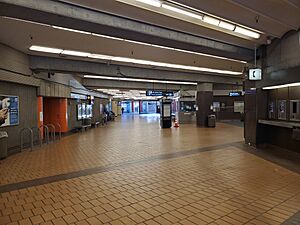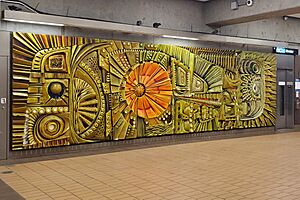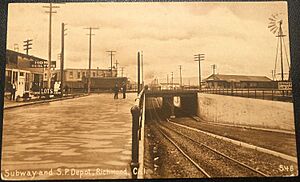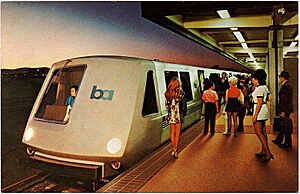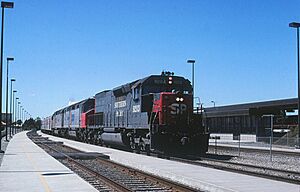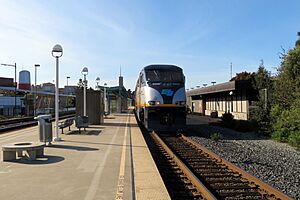Richmond station (California) facts for kids
Quick facts for kids
|
||||||||||||||||||||||||||||||||||||||||
|---|---|---|---|---|---|---|---|---|---|---|---|---|---|---|---|---|---|---|---|---|---|---|---|---|---|---|---|---|---|---|---|---|---|---|---|---|---|---|---|---|
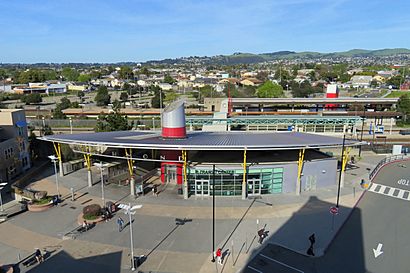
The main entrance to Richmond station in April 2018
|
||||||||||||||||||||||||||||||||||||||||
| Location | 1700 Nevin Avenue Richmond, California United States |
|||||||||||||||||||||||||||||||||||||||
| Coordinates | 37°56′12″N 122°21′11″W / 37.9368°N 122.3531°W | |||||||||||||||||||||||||||||||||||||||
| Owned by | Bay Area Rapid Transit Union Pacific Railroad (Amtrak platform) |
|||||||||||||||||||||||||||||||||||||||
| Line(s) | UP Martinez Subdivision BART R-Line |
|||||||||||||||||||||||||||||||||||||||
| Platforms | 1 island platform (Amtrak) 1 island platform (BART) |
|||||||||||||||||||||||||||||||||||||||
| Tracks | 3 (Amtrak) 2 (BART) |
|||||||||||||||||||||||||||||||||||||||
| Connections | ||||||||||||||||||||||||||||||||||||||||
| Construction | ||||||||||||||||||||||||||||||||||||||||
| Parking | 768 spaces | |||||||||||||||||||||||||||||||||||||||
| Bicycle facilities | Racks and 32 lockers | |||||||||||||||||||||||||||||||||||||||
| Architect | Maher & Martens | |||||||||||||||||||||||||||||||||||||||
| Other information | ||||||||||||||||||||||||||||||||||||||||
| Station code | Amtrak: RIC | |||||||||||||||||||||||||||||||||||||||
| History | ||||||||||||||||||||||||||||||||||||||||
| Opened | January 29, 1973 (BART) October 30, 1977 (Amtrak) |
|||||||||||||||||||||||||||||||||||||||
| Rebuilt | October 18, 2007 | |||||||||||||||||||||||||||||||||||||||
| Traffic | ||||||||||||||||||||||||||||||||||||||||
| Passengers (2020) | 4,554 (weekday average) (BART) | |||||||||||||||||||||||||||||||||||||||
| Passengers (FY2019) | 291,270 (Amtrak) | |||||||||||||||||||||||||||||||||||||||
| Services | ||||||||||||||||||||||||||||||||||||||||
|
||||||||||||||||||||||||||||||||||||||||
|
||||||||||||||||||||||||||||||||||||||||
Richmond station, also known as the Richmond Transit Center, is a major transportation hub in downtown Richmond, California. It serves both Amtrak intercity trains and Bay Area Rapid Transit (BART) commuter trains. This station is the northern end point for BART's Berryessa/North San José–Richmond and Richmond–Millbrae lines.
Amtrak trains like the Capitol Corridor, San Joaquins, and California Zephyr also stop here. The station is designed to be easy to use for everyone, including people with disabilities. It has two main platforms: one for BART trains and another for Amtrak trains. Richmond station is one of only two places where you can easily switch between BART and Amtrak trains. The other is Oakland Coliseum station.
Contents
Richmond Station: A Busy Hub
Richmond station is a key spot for travelers in the Bay Area. It connects different types of public transportation.
What You'll Find at the Station
Richmond station is located in Downtown Richmond. It's a large area surrounded by Macdonald Avenue, Marina Way, Barrett Avenue, and 19th Street. The train tracks run through the middle of this area at ground level. Bridges go over Macdonald Avenue and Barrett Avenue.
The BART platform is on the east side of the station. It's an island platform with two tracks. This is where the Berryessa/North San José–Richmond and Richmond–Millbrae lines end their journeys north. The Amtrak platform is on the west side. It's also an island platform, serving two of the three tracks used by Union Pacific Railroad trains. Amtrak's Capitol Corridor, San Joaquins, and California Zephyr trains stop here.
A special walkway called a pedestrian concourse runs under the tracks. You can enter this concourse from both ends of the station. The west entrance has a cool, curved metal roof. There's also a parking garage, a bus area, and a "kiss and ride" lane for quick drop-offs. The station is fully accessible, meaning it has elevators to help everyone reach the platforms and entrances easily.
Art at the Station
The BART part of the station was designed by Maher & Martens. You can see three pieces of public art around the station.
- A mosaic relief by William Mitchell is in the BART concourse. It's made of seashells and fiberglass and shows abstract marine life.
- On the Right Track is a series of tile murals from 2007. It was created by Jos Sances and Daniel Galvez and is in the west entrance area.
- Moving Richmond by Mildred Howard features two bent metal plates with poetry by Ishmael Reed. You can find it on the side of the parking garage.
Bus and Other Connections
Even though Richmond is a BART terminal, many local buses go to El Cerrito del Norte station. That station is closer to I-80. Still, Richmond station is served by several AC Transit bus routes. These include local routes 70, 71, 72M, 74, 76, 376, and the all-night route 800. Flixbus intercity buses and local shuttles also use the station's bus area.
How the Station Grew Over Time
The history of Richmond station goes back to the late 1800s.
Early Train Stops
The Southern Pacific (SP) opened a train line through what is now Richmond in 1878. By the mid-1880s, a small stop called Barrett's station was set up. It was named after George H. Barrett, a local landowner. At first, it was just a simple shelter where people could wave down trains.
In 1902, Barrett's station was renamed Richmond. This was because the town was growing very fast. The SP built a new station in 1904. It was a one-story building with a place for freight. In 1914–15, an even larger wooden station was built. The old station was moved and used only for freight.
Streetcars also started running to the station in 1904. At first, passengers had to get off the streetcar and walk across the train tracks. But in 1908, an underpass was built. This allowed Macdonald Avenue and the streetcars to go safely under the train tracks. Buses replaced the streetcars in 1933.
The SP station building closed in 1968 and was torn down to make way for BART construction. Trains continued to stop at a platform until Amtrak took over passenger service in 1971.
BART Arrives
Plans for a regional rapid transit system, which became BART, started as early as 1957. Voters approved the BART system in 1962. Richmond was chosen as a terminal station.
The BART station was originally planned for a different location. But it was moved to its current spot to allow for a rail yard and future expansions. Construction faced some delays due to funding issues. However, work began in 1969. The station was built by Rothschild & Raffin for $2.3 million.
BART service to Richmond began on January 29, 1973. It has been a terminal station ever since. At first, only the Richmond–Fremont line (now the Orange Line) served Richmond. Direct service to San Francisco (the Red Line) started in 1976 and became all-day service in 1980.
Amtrak Joins In
Before Richmond, there wasn't an easy place to switch between Amtrak trains and BART in the Bay Area. So, a new Amtrak station was built next to the BART station. It opened on October 30, 1977. This new station made it easier for people to connect between Amtrak's San Joaquin and long-distance trains like the San Francisco Zephyr and Coast Starlight and BART.
Over time, Amtrak service expanded. The Capitol Corridor service began in 1991. Richmond was the only place to transfer between Amtrak and BART until the Oakland Coliseum station opened its Amtrak platform in 2005.
Modernizing the Station
The original Amtrak station building closed in 1997. In 2000, plans began for a "transit village" next to the station. This project would include homes and shops. In 2001, the old Amtrak platform was replaced with a new, modern one. This new platform made it easier to get to the BART pedestrian tunnel.
A big renovation of the entire station began as part of the transit village project. It cost $6.4 million. The renovation included bigger entrances to the concourse and a new canopy over the west entrance. The station was officially renamed the Richmond Transit Center on October 18, 2007.
A large parking garage with 750 spaces opened in 2013. This replaced the old surface parking lot.
Some long-distance Amtrak trains, like the California Zephyr, started stopping at Richmond again in 2010. However, the Coast Starlight stopped coming in 2013. This was because it often arrived late at night, and passengers couldn't get out when BART was closed. To help passengers make connections, a "courtesy light" was added in 2018. It tells northbound Capitol Corridor trains to wait for two minutes if a BART train is arriving. This gives people time to switch trains.
As of 2024, there are plans for a second phase of the transit village. This will add more homes on the east side of the station.
See also
 In Spanish: Estación Richmond para niños
In Spanish: Estación Richmond para niños


